Effects of Linear Infrastructure on Ecology
Info: 12730 words (51 pages) Dissertation
Published: 24th Nov 2021
Tagged: Infrastructure PlanningEcology
Table of contents
Click to expand Contents
1. Introduction
1.1 Background
1.2 Justification
1.3 Research Questions
1.4 Research Questions
1.5 Objectives
1.6 References
2. Review of Literature
2.1 Noise
2.2 Road Traffic Noise
2.3 Road Noise Affecting Animals
2.4 Noise Affecting Animals Habitats
2.5 Rabbits
2.6 Hedgehogs
2.7 Foxes
2.8 Birds
2.9 Bats
2.10 Amphibians
2.11 References
3. Methodology
3.1 Research Methodology
3.2 Research Methods
3.3 Data Collection
3.4 Validity and Reliability
3.5 References
4. Results
4.1 Introduction
4.2 Results Presentation
4.2.1 Location A
4.2.2 Location B
4.2.3 Location C
4.2.4 Location D
4.2.5 Location E
4.3 Possible Errors
4.3.1 Calibration
4.3.2 Wind Noise
4.3.3 Outside Noise
4.3.4 Height from Road
4.3.5 Natural Sound Barriers
4.3.6 Road Noise Changes
4.3.7 Errors Summary
5. Results Discussion
5.1 Introduction
5.2 Results Summary
5.3 Comparing Results to Literature
5.4 Importance of Findings
5.5 Reducing Road Traffic Noise
6. Conclusion
6.1 Summary
6.2 Conclusions Drawn
6.3 Importance of my Research
6.4 Further Research Recommendations
6.5 Overall Conclusion
1. Introduction
Few forces have been more influential in modifying the earth than transportation. Ullman (1956). This research considers the effects that linear infrastructure can have on the ecology of an area. Linear infrastructure such as highways can affect the ecology of an area by factors such as road noise. My research shall show how factors relating to the ecology of an area can be impacted due to the road noise of linear infrastructures. This chapter contains the background, justification, aim, objectives, research questions and layout of the dissertation.
1.1 Background
The background of this dissertation covers how linear infrastructure can impact the ecology of an area. The term linear is used to describe the process of arranging or extending something in a straight line. Civil Engineers have many uses of straight lines. Infrastructure is a term architects, engineers, and urban planners use to describe essential facilities, services, and organizational structures for cities and communities. (Craven 2017). Examples of linear infrastructure include highways, bridges, waterways and power lines. Ecology is the study of how organisms interact with one another and with their physical environment. (Goldberg 2016). This could be how humans interact with animals within one environment. This dissertation considers how civil engineering is impacting this area but also combining these different aspects. Linear infrastructure affects the ecology of an area and mainly ecosystems. An ecosystem is a natural system consisting of all plants, animals and microorganisms (biotic factors) in an area functioning together with all the non-living physical (abiotic) factors of the environment (Christopherson 1997). My research shows how highways influence different parts of ecosystems such as habitats, communication, movement, reproduction, prey and animal behaviour.
1.2 Justification
The justification of this dissertation is that I, myself, live in close proximity to where the A5 Western Transport Corridor is proposed to be built. The Department of Regional Development and Transport NI plan to upgrade the current A5 road in order to improve safety, journey time, overtaking opportunities, improve North/South network links and improve links between the urban centres in the west of the province. It is planned to run from to the Irish border at Aughnacloy, via Omagh and Strabane, and finishing in Londonderry. Although the proposed road initially sounds great with the many benefits it should bring, there are some drawbacks that come with it. These negatives will impact the ecology and environment of the area most. I have always had a keen interest in wildlife as a child. I always wanted to learn about different animals that are in my area, and how their ecosystem works. I began to realise because there is such a variety of different species habituating in the area where the new road is to be constructed, it could have some detrimental effects to this wildlife and the ecology of the area. This dissertation will consider how both current and new linear infrastructure relates to the ecology of a rural environment.
1.3 Research Questions
Is there guidance relating to the design of linear infrastructure in the UK and Northern Ireland?
Yes.
Guidance for the design of linear infrastructure can be found in the Design Manual for Roads and Bridges (DMRB). The Design Manual for Roads and Bridges is a series that contains 15 volumes. These volumes contain standards, advice notes, documents and other information that relate how to design, assess and function motorways and roads. It was created in 1992 but only covered roads in England and Wales.
It was later introduced into Scotland and Northern Ireland. Volume 10 in the DMRB explains Environmental Design, with Section 1 explaining New Roads in Rural Areas. Section 1 has 7 parts including “Landform and Alignment”, “Planting, Vegetation and Soils”, “Integration with Rural Landscapes”, “The Road Corridor”, “Nature Conservation” and “Heritage, Contract and Maintenance Implementation”.
The DMRB also splits this advice into 4 regions; England, Scotland, Wales and Northern Ireland.
Although this is a reliable guide on how to build a new road in a rural area, it must be noted that this was published in 1992. Therefore, as it is 25 years old and has to be updated frequently. If civil engineers are not using the most updated version, the old techniques can in fact be negative to the ecology of an area.
What research is being done worldwide on linear infrastructure in relation to ecology?
There are lots of examples of research being done worldwide on linear infrastructure in relation to civic ecology. One example of this is in Washington, USA where research was done to see the effect on highways in relation to the wellbeing of honey bees and other pollinators.
Research was carried out to see how roadside corridors could be used as positive habitats for pollinators and especially endangered species of bees, birds, butterflies and bats. By carrying out extensive research the Department of Transportation in America was fit to restore grassland ecosystems, allowing safe habitats and ecology for pollinators to live close to the infrastructure.
Could linear infrastructure schemes such as the A5 affect local habitat?
The A5 is an infrastructure scheme which will see a dual-carriageway from Aughnacloy to Londonderry. The scheme will in total be 58 miles long, and along this distance it crosses many different ecosystems including grasslands, woodlands and rivers.
Each of these different ecosystems has different habitats for different animals. New linear infrastructure in the form of the A5 would have more negative than positive effects on wildlife habitats. One negative effect that has raised a lot of controversy on the A5 scheme is roadside noise deterring animals away from their ecosystems. Another negative would be the actual construction of the road and how it can destroy existing ecosystems. With the diverse ecosystems along the proposed route of the A5 Western Transport Corridor, new infrastructure could cause the destruction of animal’s communication, behaviour, movement, etc.
How could this be measured?
One way to measure if linear infrastructure affects ecology is to measure the pollution itself. In a scheme like the A5 one source of pollution is noise, especially road noise. Road noise is due to interaction between the road’s surface and the vehicles tyre. This can be measured by internationally used methods such as “Statistical Pass by method (SPB)”, “Close Proximity method (CPX)”, etc. After measuring the current noise there can be prevention techniques implemented when building the new road.
Porous road surfaces could be used as the road noise is absorbed into the surface rather than repelling off it. However, clogging of porous road surfaces has disastrous consequences for the sound absorption properties of the road surfaces and therefore for the achieved reduction of traffic noise.
How can best practise from other countries around the world be modified for use in Northern Ireland?
As explained earlier, parts of the current practise used in Northern Ireland for road design in rural areas is 25 years old. Therefore, parts of the DMRB have become outdated. Other countries have much more recent documents explaining the subject, which are much more relevant to today’s construction work.
One example of this is America and Washington State who has a far more recent strategy the deals with new road construction techniques, and how wildlife can live hand in hand with infrastructure. This is called the “Roadside Manual”. These documents cover issues such as Road Kill, Animal Road Aversion, Habitat Fragmentation, Pollution, Impacts on Terrestrial Habitats, Impacts on Hydrology and Cumulative Effects.
1.4 Research Questions
To assess the effect of roadside noise on the ecology of different ecosystems in County Tyrone, Northern Ireland.
1.5 Objectives
- To understand the damaging factors of high levels of road traffic noise.
- Recognise how the proximity of the road noise can affect ecology.
- How linear infrastructure road noise affects mammals.
- How linear infrastructure road noise affects amphibians.
- How linear infrastructure road noise affects birds.
1.6 References
Christopherson, Robert W, and Ginger H Birkeland. Elemental Geosystems. 2nd ed. Print.
Craven, Jackie. "Who Cares About Infrastructure?". ThoughtCo. N.p., 2017. Web. 11 Apr. 2017.
Goldberg, Jason. "Ecology". Goldiesroom.org. N.p., 2016. Web. 11 Apr. 2017.
Ullman, Edward L, and William L Thomas. Man's Role In The Changing Face Of The Earth. 1st ed. University of Chicago, 1956. Print.
2. Review of Literature
2.1 Noise
Before discussing road traffic noise, it should be first considered what noise itself is and what effects it can have. It is difficult to define noise. Acoustics and electronics distinguish sound into either noise or signal. Noise is thought to lack physical characteristics that which define a signal.
Therefore, noise can either be random or uniform. Many define noise as sound unwanted by the hearer. A more appropriate definition would be “to consider noise not as something marked off sharply and distinctly from signal, or as a definite kind of sound, but rather as one polarity of a semantic continuum with signals at one extreme and noise at the other.” Langdon (1975)1.
A-Weighted Decibel dB(A) is a unit of sound pressure level, adjusted into accordance with the A weighting scale, which takes into account the increased sensitivity of the ear at some frequencies. This is often used in environmental noise measurements and is used for measuring noise at Northern Irish airports. Battye (2010).
With noise there comes the effects of noise. With increased sound pressure levels there leads to a negative physiological effects to humans and animals. In extreme cases, 130db(A) of noise can result in deep pain, hearing damage, and even death. Traffic noise rarely exceed 85dB(A), thus defined as nuisance. This has very little physiological effects on humans, but provokes attitudes of disliking the noise.
2.2 Road Traffic Noise
Noise from road traffic may be regarded as more or less continuous sound which fluctuates from hour to hour over the day in a more or less regular fashion and from moment to moment with the passage of individual vehicles. Langdon (1975)2.
The average level for noise in quiet urban areas as 45-50dB(A), rising to 70-75dB(A) in the noisiest zones. Usually peak levels of road traffic noise with high traffic should rarely exceed 85dB(A).
Road traffic noise is an accumulation of the noise produced by vehicle’s horns, tyres, brakes, exhausts and excessive passing traffic. Traffic at low speeds creates noise primarily from the engine. Tyres and surface interaction create more noise when traffic travels at higher speeds. Engine noises are the result of radiation caused by the vibration of surfaces. This could be the exhaust, cooling fan, etc. Noise created by the action of tyres rolling on road surfaces can have a considerable influence on the total noise levels emitted by moving vehicles.
At speeds above 100km/h on dry roads, tyre-road surface noise becomes the dominant source for all but the heaviest diesel engine goods vehicles. On wet roads, speeds can be much lower to give the same degree of tyre noise. Harland (1974). Tyre noise is influenced by parameters such as vehicle speed, vehicle weight, tread pattern and material, tyre structure, tyre wear, surface water and road surface texture. An estimated 30% of the European population exposed to road traffic noise levels greater than 55dB(A) at night, well above the 40dB(A) target recommended by the World Health Organisation.
2.3 Road Noise Affecting Animals
Road noise and animals have an inconsistent relationship. It varies depending on the animal itself. Animals most affected by road noise are those that use sound to communicate and interact with others. Birds and bats are prime examples of this. If noise created by infrastructure is too loud, it will deter animals from that area. Animals often try to adapt to urban noise too. Birds tend to sing in a higher pitch than normal if they are surrounded by low frequency road noise.
To overcome these problem animals may adjust their acoustic signals in a variety of different ways including increasing the duration of brief calls (Brumm, 2004). In addition, the patterns of noise produced by traffic fluctuate in time. There may be a varying effect of road noise on animals as determined by time of day or season of the year, depending on the daily and life cycle patterns of that animal.
2.4 Noise Affecting Animals Habitats
Recent studies show that with our environment getting louder, it can have negative effects on many animals and where they locate and habitat. Natural sounds create a lot of noise too. Birdcalls, weather, migration all create sound, however animals are able to understand what this sound means. When artificial noises are introduced to a natural environment that animals cannot interpret, this is when problems may arise. Animals are less likely to habituate in these areas as the new noises can frighten them.
They also add difficulty to searching for food, navigating, mate, avoid being prey, and other normal behaviour. As these factors affect more than just one animal, it is clear that noise disrupts entire ecosystems.
The road-effect zone is the distance from the edge of the road over which significant ecological effects can be detected. Forman and Alexander (1998). Vegetation adjacent to roads often provides habitat (e.g., Bissonette and Rosa 2009), and in some landscapes, even the majority of habitat. Van der Ree and Bennett (2003). Wildlife that have habitats within the road effect zone will experience traffic noise and likely be affected by it. Anthropogenic noise has the potential to severely disrupt the communication of species by acoustic interference or masking. Van der Ree (2011).
2.5 Rabbits
We must understand that rabbits do not make much noise when communicating. The loudest noise they will make is a squeal, which usually indicates they are scared or distressed. They much prefer to use gestures such as thumping on the ground to show their emotions.
This thumping is used to alert other rabbits of danger nearby. Some of the more delicate sounds a rabbit makes tells a lot about how it currently feels.
A small clucking sound can indicate that a rabbit is content. If a rabbit growls it is threatened. This is used to protect territory from other rabbits.
A honk like sound is used if a rabbit does not like a situation. Teeth grinding can indicate that a rabbit is in pain, and perhaps injured.
A wheezing or whining noise can show that a rabbit may have a breathing difficulty. This can also mean that it is curious so it is very hard to recognise the two separate noises.
Grunting noises made by male rabbits to show that they are looking to mate. This is usually followed by circling a female.
Due to these noises being so quiet, rabbits find communication difficult in noisy areas, such as roads and other infrastructure.
Highway 59 is a two-lane rope of asphalt that rolls across the flatlands of northeast Wyoming and slices through the Thunder Basin National Grassland. These days, the road is littered with the bodies of rabbits that have paid dearly in their quest for the green grass, water and warmth the roadway provides. Tosches (2006).
Due to the high risk of mortality, inability to communicate and lack of food available, areas of infrastructure are recognised as poor locations for rabbits to habituate.
2.6 Hedgehogs
The Western European hedgehog (Erinaceus europaeus) is one of four species within the genus Erinaceus. Pfäffle (2010). The Erinaceus europaeus, also known as the Common Hedgehog, and can be found all through Europe including the UK.
While most Erinaceus europaeus populations are steady, the UK population is diminishing. The common habitat for the European hedgehog is grassland, meadows, woodland and pastures. It is estimated that there is fewer than a million hedgehogs currently in Great Britain. Vaughan (2013). This species is currently listed as a UK priority species.
Hedgehogs have a much-mocked relationship with cars and roads – and it is likely that at least 100,000 are killed each year (probably more than 10% of the population). Warwick (2016). It is estimated that in Great Britain 15,000 hedgehogs die on roads every year. Morris (2006).
The main problem that infrastructure causes upon the hedgehog species is not road traffic noise. Although the road traffic noise can cause problems by distressing these small mammals, causing them to acclimatise far from nearby roads. Instead, it is the barriers that the infrastructure creates which leads to their death.
Road mortality is the second biggest killer of the European hedgehog, behind starvation. Hedgehogs forage for their food, mainly slugs, worms and insects. When foraging they can cover hectares of land.
New infrastructure such as roads and highways can create barriers for hedgehogs searching for food. As a hedgehog is not a very quick or agile animal, crossing roads more than likely results in death. The animal’s main form of defence when frightened is to curl into a ball and stay motionless to protect itself. This then results in traffic colliding with the mammal, resulting in death.
2.7 Foxes
The red fox, also known as the Vulpes vulpes, can be located in many countries including Britain. Red Foxes are adaptable and opportunistic omnivores and are capable of successfully occupying urban areas. MacDonald (2008).
Foxes mostly feed on small mammals, small birds and vermin. Foxes are a territorial animal and identify their territory by spraying urine at nose height to tell other foxes. Foxes in Ireland usually habituate in areas offering a wide range of food and cover. The fox is a solitary animal that does not hunt as a pack. Looney (2017). A fox lives in a den. A den is usually in woodland and provides shelter to the fox. Foxes burrow to create their own den or reuse a previous foxes den.
Rural foxes tend to build dens that are in quiet areas where they will be undisturbed; however, urban foxes have adapted to live within cities. Vulpes vulpes build dens away from infrastructure. Infrastructure such as roads both provide danger to themselves and offspring, increases difficulty to prey and limit communication between foxes. Often foxes come to roads to feed on carcases from the result of roadkill.
However, with this many foxes hit by oncoming traffic and thus result in death. Road traffic noise is a great disadvantage to Vulpes vulpes. A fox must use its fine tuned senses to detect prey. At night-time, a fox’s sight is limited so it primarily uses its hearing to locate prey. A small mouse, which is a main form of food for the rural fox, produces sound at roughly 63dB (A). Road traffic noise, which exceeds this, creates great difficulty for a fox to hunt.
2.8 Birds
One animal greatly affected by increased road noise are birds. Bird diversity and habitat patterns are thought to have been decreasing in urban areas, particularly close to roadways, due to increased noise levels. Many birds have also had to change their behaviours to be heard even with the noise.
Urban great tits for example, are able to raise the frequency of their calls to reduce acoustical masking by predominantly low-frequency urban noise, while European robins adjust the timing of their singing to coincide with quieter periods in the city. Haslam (2015).
Bird population also tends to reduce when deforestation takes place in the construction of infrastructure. When infrastructure such as a road is built in a woodland or forest area deforestation is often required. Heavy plant and machinery are used to strip trees from the area and dig up masses of roots. The removal of trees leads to the deletion of habitats as the birds nest high in these trees. The noise production and vibration from the heavy plant also deters birds from these habitats. The increased noise stops them from interacting to others and loud crashes often scare them away. The vibration caused by the machinery makes it problematic and distracting for nest building and breeding patterns.
This results in depopulation and habituation elsewhere. If vegetation is kept in place close to infrastructure, it reduces the depopulation as its thought the trees reduce the animal’s visibility of the road and reduced the sound emitted from it.
A common, widespread bird throughout Northern Ireland is the great tit (Parsus Major). It is the largest of the tit family and is black, yellow and white in colour. Its diet is usually insects, seeds and nuts. The great tit uses its call as a way to alarm other wild birds of danger and a predator within the area. This call has been recorded at roughly 56 dB(A). Templeton (2016). Birds are adapting to background noise. One such short-term adaptation is the Lombard effect, in which a signaller increases the amplitude of its vocalizations in response to an increase of the background noise amplitude. Lombard (1911).
Background noise, such as road traffic noise may cause a Lombard effect with birds, causing them to call slightly higher in order to try and be heard.
2.9 Bats
As bats roost in both bridges and box culverts, and search for food along highways, they are affected by road transport noise. A common bat in Northern Ireland is the Common Pipistrelle. The Common Pipistrelle bat use sound to prey, mate, and communicate. Males and establish mating territories during August. The mating period extends to October and male bats are particularly vocal at this time producing many social calls to attract a mate. Russ (2001).
Currently there is limited information as to whether bats respond negatively or positively to anthropogenic noise. Bats are known to abandon roosts in caves, mines, and some buildings when directly disturbed by human activities. Keeley and Tuttle (1999).
Traffic noise can potentially deter some bats from feeding alongside and crossing over highways. Schaub et al (2008). In contrast, large colonies of bats e.g., the Brazilian free‐tailed bat) commonly roost in very large numbers in bridges with a high level of traffic, suggesting traffic noise does not bother the colonies roosting there. Taylor (2013).
2.10 Amphibians
Amphibians are animals that survive both on land and in water, but lays its eggs in the water. Several amphibians can be found in Britain. Salamanders, newts, frogs and toads can be found habituating in marshland, lakesides, woodland, fields and pond throughout the UK.
Amphibians are subject to noise as it disrupts their communication. Like birds, it's only the male frogs that call. Females can make short chirpy sounds or peeps. The male's calls advertise their species, general fitness, size, territory, and location to other males and females. This type of acoustic communication is vital to creatures that mate and breed in ponds which can often be quite large. McDonald (2015).
In most frog species, successful reproduction critically depends on acoustic communication. Gerhardt and Huber (2002). The advertisement or mating call of a frog contains key information about species identity and an individual’s motivation to reproduce. Velásquez et al. (2013). Frogs communicate their mating call by inflating their vocal sac. By pulsating the vocal sac the attractiveness of male increases to a female frog. In general, female frogs prefer calls that are energetically costly to produce. These could include calls that are louder, longer, and/or have a higher repetition rate, i.e., calls with high values for dynamic properties. Gerhardt and Huber (2002).
The common frog or Rana Temporaria is the most recognised amphibian in Northern Ireland. Adult males grow to 9 cm long and females 13 cm long. They are usually brown or olive in colour with dark patches. Their call is a very soft repetitive croak. The common frog has quite sensitive hearing. It hears by using both the eardrums and the lungs to intercept sound. The frog uses a pressure system that reduces vibrations from a frogs own call, thus stopping the frog from causing hearing damage to itself. The common frog communicates in croaks of 42 dB(A).
Anthropogenic noises from infrastructure can interfere with these calls, thus resulting in a decline of Rana Temporaria roadside habitats.
2.11 References
Brumm, Henrik and Wolfgang Goymann. Journal of Ornithology, 2004. Print.
Forman, Richard T. T., and Lauren E. Alexander. "ROADS AND THEIR MAJOR ECOLOGICAL EFFECTS". Annual Review of Ecology and Systematics 29.1 (1998): 207-231. Web.
Harland, D. G. Rolling Noise And Vehicle Noise. 1st ed. Crowthorne: Road Research Laboratory, 1974. Print.
Langdon, FJ, and Ariel Alexandre. Road Traffic Noise. 1st ed. London: Applied Science Publishers, 1975. Print.1
Langdon, FJ, and Ariel Alexandre. Road Traffic Noise. 1st ed. London: Applied Science Publishers, 1975. Print.2
Bissonette, John A., and Silvia A. Rosa. "Road Zone Effects In Small-Mammal Communities". Ecology and Society 14.1 (2009): n. pag. Web.
Van der Ree, Rodney et al. "Effects Of Roads And Traffic On Wildlife Populations And Landscape Function: Road Ecology Is Moving Toward Larger Scales". Ecology and Society 16.1 (2011): n. pag. Web.
Van der Ree, Rodney, and Andrew F. Bennett. "Home Range Of The Squirrel Glider (Petaurus Norfolcensis) In A Network Of Remnant Linear Habitats". Journal of Zoology 259.4 (2003): 327-336. Web.
Keeley, Brian W, and Merlin D Tuttle. Bats In American Bridges. 1st ed. Austin, Texas: Bat Conservation International Incorporated, 1999. Print.
Schaub, A., J. Ostwald, and B. M. Siemers. "Foraging Bats Avoid Noise". Journal of Experimental Biology 211.19 (2008): n. pag. Web.
Taylor, Peter John, Ara Monadjem, and Jacobus Nicolaas Steyn. "Seasonal Patterns Of Habitat Use By Insectivorous Bats In A Subtropical African Agro-Ecosystem Dominated By Macadamia Orchards". African Journal of Ecology 51.4 (2013): n. pag. Web.
Tosches, Rich. "Luck Runs Out When Rabbits Hit Road – The Denver Post". Denverpost.com. N.p., 2006. Web. 18 Apr. 2017.
McDonald, Karen. "How Do Frogs Make Sound And Hear It? - The Infinite Spider". The Infinite Spider. N.p., 2015. Web. 18 Apr. 2017.
Parris, K. M., M. Velik-Lord, and J. M. A. North. 2009. Frogs call at a higher pitch in traffic noise. Ecology and Society 14(1): 25. Web. 18 Apr. 2017.
Gerhardt, H. Carl, and Franz Huber. Acoustic Communication In Insects And Anurans. 1st ed. Chicago: University of Chicago Press, 2002. Print.
Velásquez, Nelson A. et al. "Bioacoustic And Genetic Divergence In A Frog With A Wide Geographical Distribution". Biological Journal of the Linnean Society 110.1 (2013): 142-155. Web.
Pfäffle, M. P. 2010. Influence of parasites on fitness parameters of the European hedgehog (Erinaceus europaeus). PhD thesis, Karlsruher Institut für Technologie (KIT) – Universitätsbereich vorgelegte. Vaughan, Adam. "Hedgehog Population In Dramatic Decline". the Guardian. N.p., 2013. Web. 19 Apr. 2017.
Warwick, Hugh. "Why Have Hedgehogs Declined? You Asked Google – Here’S The Answer | Hugh Warwick". the Guardian. N.p., 2016. Web. 19 Apr. 2017.
Morris, P.A. (2006) The New Hedgehog Book. Whittet Books Ltd, Stowmarket. Print. Battye, David. "NOISE MEASUREMENT OF AIR TRAFFIC IN NORTHERN IRELAND". NI Assembly. N.p., 2010. Web. 19 Apr. 2017.
Macdonald, D. W.; Reynolds, J. C. (2008). "'Vulpes vulpes'". IUCN Red List of Threatened Species. Version 2008. International Union for Conservation of Nature. Looney, D. (2017). Fox | The Vincent Wildlife Trust. [online] Mammals-in-ireland.ie. Available at: http://www.mammals-in-ireland.ie/species/species-2 [Accessed 19 Apr. 2017].
Russ, J. (2001). Northern Ireland's Mammals, Amphibians & Reptiles. [online] Habitas.org.uk. Available at: http://www.habitas.org.uk/nimars/index.htm?page=/nimars/ppipistrellussd.htm [Accessed 24 Apr. 2017].
Haslam, J. (2015). How noise pollution is changing animal behaviour. [online] The Conversation. Available at: http://theconversation.com/how-noise-pollution-is-changing-animal-behaviour-52339 [Accessed 24 Apr. 2017].
Templeton, C., Zollinger, S. and Brumm, H. (2016). Traffic noise drowns out great tit alarm calls. Current Biology, 26(22), pp.R1173-R1174.
Lombard, E. (1911) Le signe de l’élévation de la voix. Annales Des Maladies de l’Oreille et Du Larynx, 37, 101–119.
3. Methodology
3.1 Research Methodology
Research methodology refers to the principles and procedures of logical thought processes which are applied to a scientific investigation. Fellows and Liu (1997).
The purpose for my research is to understand how road traffic noise from new linear infrastructure can affect nearby wildlife.
The methodology that I have chosen for this research is quantitative. Quantitative research is generating data that can then be displayed as statistics. These statistics are used to quantify the problem. The quantitative research can be used to prepare facts and discover patterns and trends. Some methods of quantitative research include surveys, laboratory experiments, mathematic modelling, econometrics, etc.
Some types of data used are numerical, non-numerical, continuous, discrete, etc. By using quantitative research, I can collect data on road traffic noise, compare it against wildlife sound, and compare both sets of data. Statistics and facts will be drawn from this data.
3.2 Research Methods
My method for measuring sound pressure levels will be collected using two devices. I will be using a smart phone and a tablet to record any sound emitted in dB (A).
Sound will be recorded using two separate apps, both available to download on Android. I chose two devices and apps rather than one. This allows me to compare data, and to ensure readings were accurate. The smart phone app I will be using is called “Sound Meter”. You calibrate the app before using and then can record sound. It gives minimum, maximum and average values on screen as well as a graph to show sound over time. The tablet app I will use is called “Sound Meter & Noise Detector”. It is similar to the “Sound Meter” app as it too shows minimum, maximum and average values. This should make it very easy to compare the results during data analysis. The two devices I will use are a Samsung Galaxy S6 smart phone and a Sony Experia Z4 tablet.
First of all, I will choose a location to record sound. The location must be a busy road with different ecology and environments close by. All recordings must take place between the hours of 1000 and 1700 hours to get the peak levels of road traffic noise. Recordings will take place at 10 metre intervals between 0 and 100 metres of the roadside. Each recording will last 5 minutes to ensure that minimum, maximum and average values are given.
3.3 Data Collection
When collecting data, I must use several pieces of equipment. This includes a smart phone, tablet, PPE if necessary, a measuring tape, and data collection sheets. The location I have chosen to collect data are on the current A5 road between Ballygawley and Omagh. I selected locations here as they are areas that contain a diverse variety of wildlife, ecosystems and ecology.
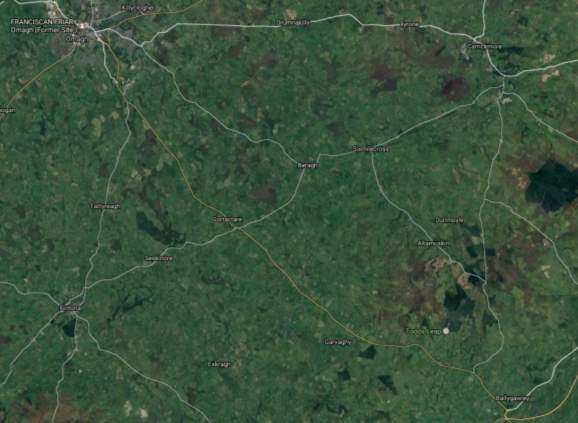
This area is also containing very similar ecology to the proposed A5 WTC through this area.
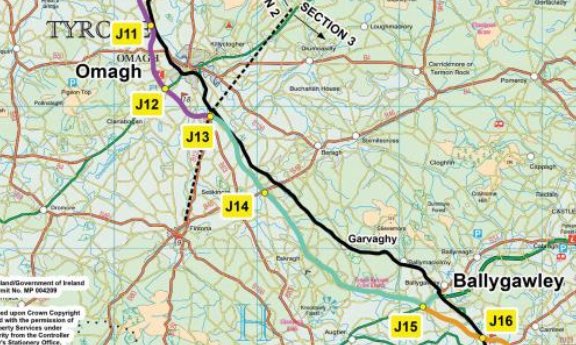
https://www.infrastructure-ni.gov.uk/articles/a5-western-transport-corridor-overview

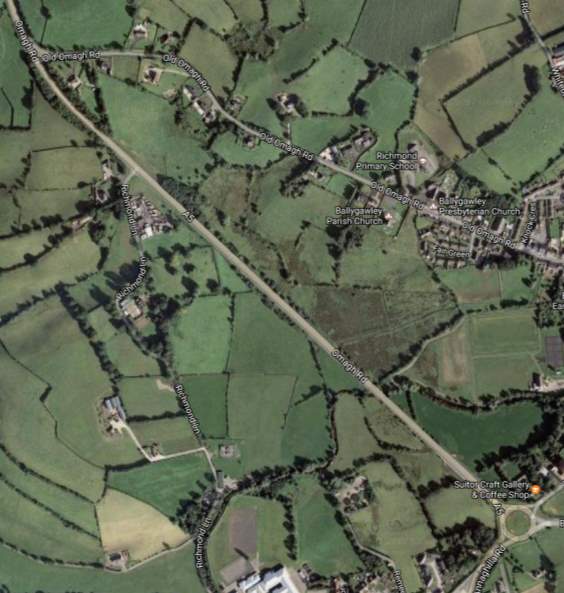
A
 Key: Location:
Key: Location:  Direction to record dB (A):
Direction to record dB (A): 
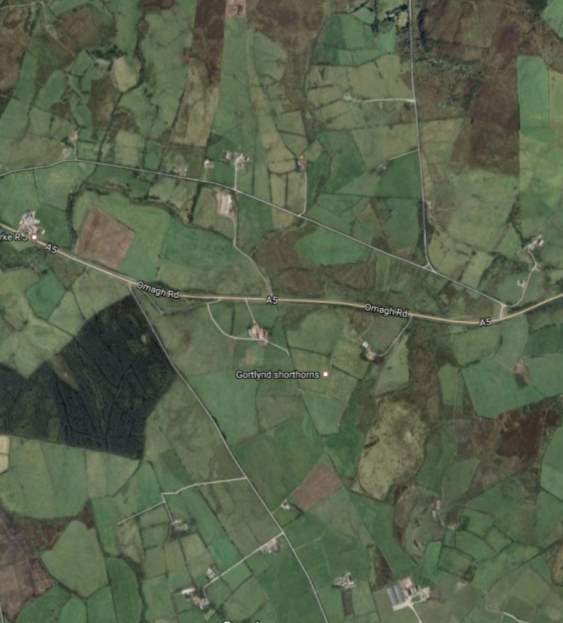
B
 Key: Location:
Key: Location:  Direction to record dB (A):
Direction to record dB (A): 
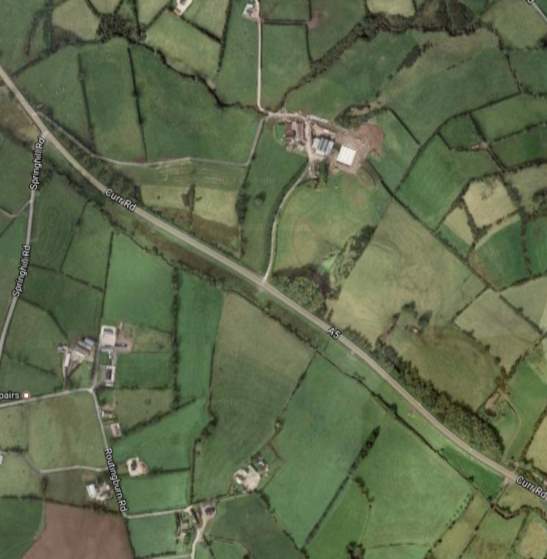
C
 Key: Location:
Key: Location:  Direction to record dB (A):
Direction to record dB (A): 
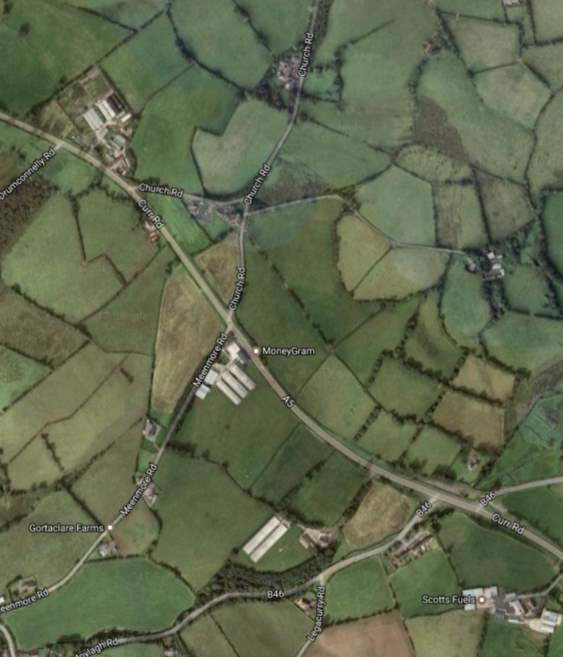
D
 Key: Location:
Key: Location:  Direction to record dB (A):
Direction to record dB (A): 
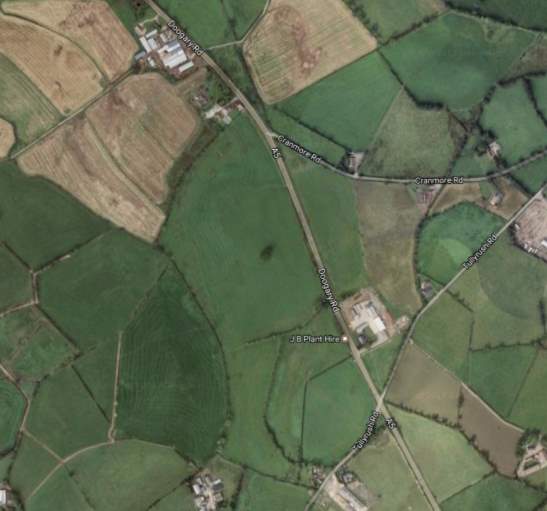
E

Key: Location:  Direction to record dB (A): An example of a blank data collection sheet is shown as follows.
Direction to record dB (A): An example of a blank data collection sheet is shown as follows.
| Location | ||||||
| Distance (m) | Smart Phone (dB(A)) | Tablet (dB(A)) | ||||
| Minimum | Maximum | Average | Minimum | Maximum | Average | |
| 0 | ||||||
| 10 | ||||||
| 20 | ||||||
| 30 | ||||||
| 40 | ||||||
| 50 | ||||||
| 60 | ||||||
| 70 | ||||||
| 80 | ||||||
| 90 | ||||||
| 100 | ||||||
When all sheets are completed, we can compare the data with wildlife sounds. Using graphs, we can see how the road traffic noise interferes with animal calls at different ranges from the road. From this, we can assess how close animals can live to infrastructure without being disturbed.
3.4 Validity and Reliability
Validity is how credible the research carried out is. Reliability shows that if the same methods were to be repeated it would yield the same results. To ensure both validity and reliability are met some methods were used.
Before recording any data on either device, calibration has to be carried out. Calibration allows any data given to be accurate, thus allowing comparison of data as both sets are accurate.
By using a measuring tape, I can accurately measure how far from the roadside I should be measuring from. A minimum, maximum and average noise value is the most important data to record, as this will allow us to compare all the different data in different locations.
3.5 References
Fellows, R. and Liu, A. (1997). Research methods for construction. Oxford: Blackwell Publishing.
4. Results
4.1 Introduction
The results I obtained from by data collection have been displayed below. I displayed these results in both tabular and graphical form. Both ways of displaying the results show how dB (A) changes by distance from the road.
4.2 Results Presentation
4.2.1 Location A
| Location | A | |||||
| Distance (m) | Smart Phone (dB(A)) | Tablet (dB(A)) | ||||
| Minimum | Maximum | Average | Minimum | Maximum | Average | |
| 0 | 47 | 87 | 82 | 44 | 89 | 84 |
| 10 | 47 | 86 | 82 | 41 | 88 | 82 |
| 20 | 45 | 84 | 78 | 45 | 86 | 80 |
| 30 | 46 | 85 | 75 | 43 | 87 | 77 |
| 40 | 45 | 82 | 70 | 44 | 86 | 74 |
| 50 | 41 | 78 | 65 | 38 | 76 | 67 |
| 60 | 42 | 81 | 62 | 36 | 80 | 63 |
| 70 | 38 | 77 | 57 | 39 | 84 | 59 |
| 80 | 39 | 69 | 55 | 37 | 79 | 57 |
| 90 | 35 | 72 | 49 | 36 | 83 | 52 |
| 100 | 36 | 64 | 44 | 37 | 70 | 49 |
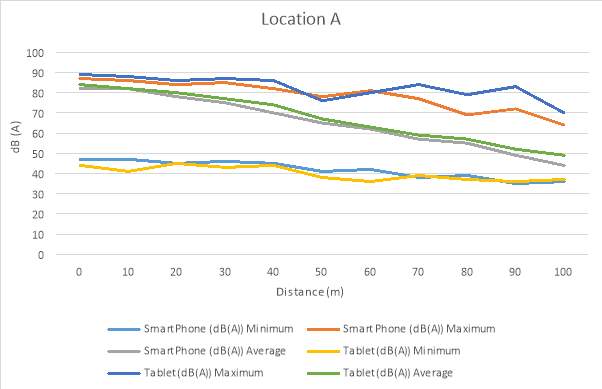
From location A we can see both the smart phone and tablet had similar results of dB (A) against distance. The minimum and average values of noise only differed in a few decibels at each interval. The maximum dB (A) was larger in the tablet’s readings compared to the smart phone particularly between the 70 metre to 100 metre zone.
The smart phone’s maximum dB (A) peaked at 0m reading 87 dB (A), with the lowest value being 64 dB (A) at 100m.
The tablet’s maximum dB (A) peaked at 0m also, but gave a larger reading of 89 dB (A).
The tablets lowest maximum reading was 70 dB (A), too at 100m. The smart phone’s minimum dB (A) peaked at both 0m and 10m reading 47 dB (A). The lowest minimum value was at 90m reading 35 dB (A). The tablet’s minimum dB (A) peaked at 20m reading of 45 dB (A) with the lowest minimum reading being 37 dB (A) at 80m and 100m.
The smartphone’s average was at its highest at 0m reading 82 dB (A). This steadily decreased until 44 dB(A) at 100m. The tablet’s average was also at its highest at 0m reading a slightly higher value of 84 dB (A). This steadily decreased until 49 dB(A) at 100m which was 5dB (A) higher than the smart phone’s results.
4.2.2 Location B
| Location | B | |||||
| Distance (m) | Smart Phone (dB(A)) | Tablet (dB(A)) | ||||
| Minimum | Maximum | Average | Minimum | Maximum | Average | |
| 0 | 42 | 84 | 79 | 41 | 87 | 81 |
| 10 | 43 | 84 | 78 | 44 | 86 | 80 |
| 20 | 42 | 82 | 76 | 40 | 85 | 78 |
| 30 | 42 | 80 | 75 | 42 | 82 | 76 |
| 40 | 41 | 76 | 71 | 40 | 78 | 73 |
| 50 | 40 | 77 | 62 | 42 | 77 | 68 |
| 60 | 38 | 73 | 64 | 38 | 76 | 62 |
| 70 | 36 | 69 | 58 | 37 | 75 | 58 |
| 80 | 36 | 62 | 54 | 36 | 69 | 56 |
| 90 | 37 | 65 | 49 | 37 | 63 | 53 |
| 100 | 37 | 62 | 43 | 37 | 63 | 46 |
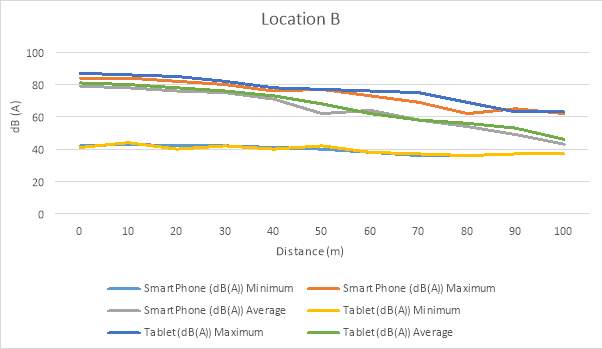
From location B we can see both the smart phone and tablet also had similar results of dB (A) against distance. The minimum, maximum and average values of noise only differed in a few decibels at each interval. Again the maximum dB (A) was larger in the tablet’s readings compared to the smart phone’s.
This occurred between the 60 metre to 80 metre distance. The smart phone’s maximum dB (A) peaked at 0m and 10m, both reading 84 dB (A). This time the lowest value was at both 80m and 100m being 62 dB (A). The tablet’s maximum dB (A) peaked at 0m also, again with a larger reading of 87 dB (A). The tablets lowest maximum reading was 63 dB (A), at both 90m and 100m. The smart phone’s minimum dB (A) peaked at 10m with a reading of 43 dB (A). The lowest minimum value was at 70m and 80m reading 36 dB (A). The tablet’s minimum dB (A) peaked at 10m reading of 44 dB (A) with the lowest minimum reading being 36 dB (A) at 80m. The smartphone’s average was at its highest at 0m reading 79 dB (A), slightly lower than Location A. This steadily decreased until 62 dB(A) at 50m, rising to 64dB(A) at 60m, then again decreasing to 43 dB (A) at 100m. The tablet’s average was also at its highest at 0m reading 81 dB (A). This steadily decreased to 46 dB(A) at 100m, again slightly higher than the smart phone’s results.
4.2.3 Location C
| Location | C | |||||
| Distance (m) | Smart Phone (dB(A)) | Tablet (dB(A)) | ||||
| Minimum | Maximum | Average | Minimum | Maximum | Average | |
| 0 | 45 | 86 | 80 | 42 | 88 | 82 |
| 10 | 45 | 84 | 79 | 43 | 88 | 82 |
| 20 | 45 | 83 | 77 | 41 | 88 | 81 |
| 30 | 43 | 82 | 73 | 40 | 87 | 81 |
| 40 | 40 | 78 | 70 | 41 | 84 | 75 |
| 50 | 40 | 75 | 67 | 40 | 82 | 73 |
| 60 | 37 | 76 | 64 | 38 | 78 | 67 |
| 70 | 36 | 68 | 60 | 36 | 78 | 66 |
| 80 | 37 | 67 | 59 | 37 | 74 | 60 |
| 90 | 38 | 68 | 57 | 35 | 71 | 61 |
| 100 | 36 | 63 | 50 | 36 | 65 | 54 |
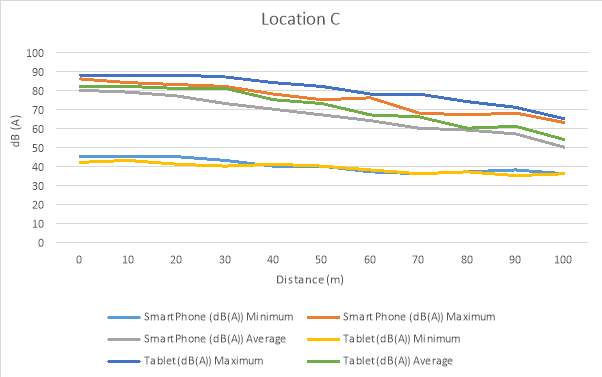
From location C we can see both the smart phone and tablet had similar trends of dB (A) against distance, however this time the figures differed in values between devices at the intervals. The maximum and average values of noise appeared much higher on the tablet’s readings compared to the smart phone’s. In one instance the tablet’s maximum reading differred by 10 dB (A) to the smart phone’s at 70m. The smart phone’s maximum dB (A) peaked at 0m reading at 86 dB (A), with the lowest value being 63 dB (A) at 100m. The tablet’s maximum dB (A) peaked between the range of 0m to 30m which read 88 dB (A). The tablets lowest maximum reading was 65 dB (A) at 100m, which was a lot less than the other maximum values. The smart phone’s minimum dB (A) peaked between 0m to 20m reading 45 dB (A). The lowest minimum value was at both 70m and 100m reading 36 dB (A). The tablet’s minimum dB (A) peaked at 10m reading 43 dB (A). The lowest minimum reading on the tablet was just lower to that of the smartphone’s, reading 35 dB (A) again at 90m. The smartphone’s average was at its highest at 0m reading 80 dB (A). This steadily decreased until 50 dB(A) at 100m, higher than both Locations A and B. The tablet’s average was at its highest between 0mand 10m, reading a higher value of 82 dB (A). This steadily decreased until 54 dB(A) at 100m which was again higher than both Locations A and B.
4.2.4 Location D
| Location | D | |||||
| Distance (m) | Smart Phone (dB(A)) | Tablet (dB(A)) | ||||
| Minimum | Maximum | Average | Minimum | Maximum | Average | |
| 0 | 46 | 86 | 81 | 42 | 88 | 82 |
| 10 | 42 | 88 | 81 | 46 | 87 | 81 |
| 20 | 43 | 86 | 80 | 44 | 86 | 80 |
| 30 | 41 | 85 | 78 | 44 | 84 | 77 |
| 40 | 42 | 82 | 74 | 41 | 81 | 76 |
| 50 | 40 | 80 | 73 | 40 | 78 | 72 |
| 60 | 41 | 77 | 66 | 40 | 75 | 68 |
| 70 | 40 | 75 | 68 | 41 | 74 | 64 |
| 80 | 38 | 71 | 63 | 37 | 70 | 64 |
| 90 | 37 | 70 | 57 | 37 | 68 | 63 |
| 100 | 33 | 67 | 55 | 38 | 70 | 58 |
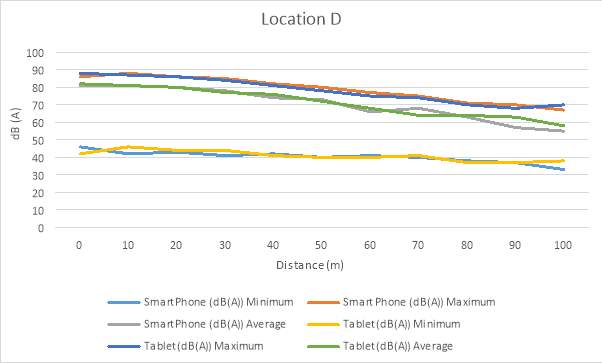
From location D we can see both the smart phone and tablet had very clean results with no major anomalies. The graph shows that both the smart phone and tablet produced similar readings with both lines nearly matching eachother. The average value of noise on the smart phone slightly dipped between 80m to 100m but that is the only real difference. The smart phone’s maximum dB (A) peaked at 10m reading 88 dB (A), with the lowest value being 67 dB (A) at 100m. The tablet’s maximum dB (A) peaked at 0m, but giving the same reading of 88 dB (A). The tablets lowest maximum reading was 68 dB (A) at the 90m interval. The smart phone’s minimum dB (A) peaked at both 0m reading 46 dB (A). The lowest minimum value was at 100m reading a very low 33 dB (A) value. The tablet’s minimum dB (A) peaked at 10m, also reading 46 dB (A) with the lowest minimum reading being 37 dB (A) at 80m and 90m. The smartphone’s average was at its highest at both 0m and 10m reading 81 dB (A). This steadily decreased until 66 dB(A) at 60m, rising to 68 dB(A) at 70m, then steadily decreasing to 55 dB (A) at 100m. The tablet’s average was also at its highest at 0m reading a similar value of 82 dB (A). This steadily decreased until 58 dB(A) at 100m.
4.2.5 Location E
| Location | E | |||||
| Distance (m) | Smart Phone (dB(A)) | Tablet (dB(A)) | ||||
| Minimum | Maximum | Average | Minimum | Maximum | Average | |
| 0 | 48 | 89 | 85 | 41 | 89 | 84 |
| 10 | 41 | 89 | 83 | 44 | 89 | 84 |
| 20 | 44 | 89 | 83 | 44 | 88 | 82 |
| 30 | 40 | 82 | 77 | 40 | 81 | 76 |
| 40 | 40 | 77 | 72 | 40 | 78 | 74 |
| 50 | 40 | 76 | 70 | 37 | 76 | 70 |
| 60 | 39 | 70 | 63 | 38 | 73 | 66 |
| 70 | 35 | 70 | 61 | 37 | 74 | 63 |
| 80 | 37 | 72 | 62 | 36 | 72 | 60 |
| 90 | 35 | 65 | 52 | 36 | 64 | 58 |
| 100 | 34 | 62 | 54 | 35 | 66 | 57 |
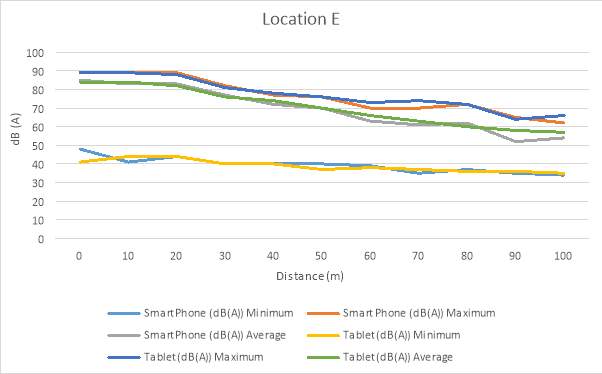 Finally at location E we can see once again that both the smart phone and tablet had similar results of dB (A) against distance. The values of noise only differed in a few decibels at each interval. Yet again the tablet’s readings came out slightly higher compared to the smart phone’s readings. The smart phone’s maximum dB (A) peaked at 0m, 10m and 20m reading a value of 89 dB (A), with the lowest value reading 62 dB (A) at 100m. The tablet’s maximum dB (A) peaked at 0mand 10m with an identical reading of 89 dB (A). The tablets lowest maximum reading was 64 dB (A), at the 90m range. The smart phone’s minimum dB (A) peaked at 0m distance with a reading of 48 dB (A). The lowest minimum value was at 100m reading 34 dB (A). The tablet’s minimum dB (A) peaked at 10m and 20m with a reading of 44 dB (A) with the lowest minimum reading being 35 dB (A) at 100m. The smartphone’s average was at its highest at 0m reading 85 dB (A). This steadily decreased until 61 dB (A) at 70m, increasing to 62 dB (A) at 80 m before decreasing again to 52 dB(A) at 90m, and increasing to 54 dB (A) at 100m. The tablet’s average was at its highest at 0m and 10m reading a value of 84 dB (A). This steadily decreased all the way down to 57 dB(A) at 100m.
Finally at location E we can see once again that both the smart phone and tablet had similar results of dB (A) against distance. The values of noise only differed in a few decibels at each interval. Yet again the tablet’s readings came out slightly higher compared to the smart phone’s readings. The smart phone’s maximum dB (A) peaked at 0m, 10m and 20m reading a value of 89 dB (A), with the lowest value reading 62 dB (A) at 100m. The tablet’s maximum dB (A) peaked at 0mand 10m with an identical reading of 89 dB (A). The tablets lowest maximum reading was 64 dB (A), at the 90m range. The smart phone’s minimum dB (A) peaked at 0m distance with a reading of 48 dB (A). The lowest minimum value was at 100m reading 34 dB (A). The tablet’s minimum dB (A) peaked at 10m and 20m with a reading of 44 dB (A) with the lowest minimum reading being 35 dB (A) at 100m. The smartphone’s average was at its highest at 0m reading 85 dB (A). This steadily decreased until 61 dB (A) at 70m, increasing to 62 dB (A) at 80 m before decreasing again to 52 dB(A) at 90m, and increasing to 54 dB (A) at 100m. The tablet’s average was at its highest at 0m and 10m reading a value of 84 dB (A). This steadily decreased all the way down to 57 dB(A) at 100m.
4.3 Possible Errors
Although I am confident that the research I completed and results I obtained are accurate, there may have be some errors that took place during the experiment. These errors could result in some inaccurate results. These errors could also cause someone else completing the same experiment to have different results to my own.
4.3.1 Calibration
Before any scientific measurement is taken with any microphone, calibration is required. Due to the precise sensitivity of the microphone, it is important that it give the correct readings. Before setting out to take readings, I calibrated both devices together. I ensured that in the same environment that both sound meters were giving the same reading. This meant that out beside the road the readings should be the same. However, as shown on the tables and graphs sometimes the two sound meters displayed different results. This may have been due to the microphone changing slightly between the time of calibration and the time of recording results.
4.3.2 Wind Noise
Wind noise is caused by wind striking the surface of a microphone. Wind noise can cause changes in values in recordings of a microphone. As there was wind present when I recorded my readings this may have affected some of my results. The easiest way of preventing wind noise is to prevent it from striking the microphone. This is done by using either foam windscreens or fur windscreens. By using these windscreens, any wind cannot strike the surface of the microphone directly, thus not picking up the unwanted noise. Perhaps if I was to do this experiment again I would invest in a foam or fur windscreen in case wind did effect my results.
4.3.3 Outside Noise
My experiment was to collect noise caused by road traffic. As I took readings further away from the roadside I noticed other noises may have been picked up by the sound meter. As the areas I took the results were in a rural environment there was some outside noise. Being a rural area there was some agriculture present, thus noises from farm animals and machinery may have interfered with recordings. Also the further from the road I went I could faintly hear birdcalls. This was interesting as I am examining how road traffic noise affects animals and their communication. Although it was fascinating to note the presence of animals, their calls could in fact have altered my readings, thus leading to errors.
4.3.4 Height from Road
One factor that may have had an impact on my data is the height of my recordings compared to that of the road. In almost all locations I took recordings, the roadside was not flat. Often it either inclined or declined the further I travelled from the road. This can influence the amount of noise heard from the road traffic. By being above the road on an incline, the noise can often sound quieter as you are not ear level with the noise. With height other factors affect hearing too as wind can increase, thus not giving entirely accurate readings. For optimum, accurate data all recordings should be took level with the road, however this sometimes just is not possible.
4.3.5 Natural Sound Barriers
Natural sound barriers can influence noise readings by absorbing, refracting, deflecting and reflecting the noise. This reduces the noise heard. Natural sound barriers are usually in the form of vegetation. Vegetation such as trees, hedges and shrubs can be barriers of noise. As it was rural areas I was recording my results, I came across several types of this vegetation. The main forms I encountered where hedges and trees. This may have cause absorption, refraction, deflection and reflection of road traffic noise from my sound meters. This would explain sudden drops in dB (A) in some of my data collected.
4.3.6 Road Noise Changes
Road traffic noise can change day to day. Many factors can affect the levels of noise produced. One instance is how much moisture is on the road surface. A wet road produces more noise than a dry road. Different road surfaces also can affect the noise produced. Some road surfaces can absorb noise whereas others deflect the noise outwards. Wind direction can affect noise. If you are facing the direction the wind is blowing, you will pick up larger readings than normal. One final factor that can change daily is the traffic itself. If there are larger amounts of traffic on a road the noise, levels will increase. If traffic travels faster, it too will be louder. To get more accurate results I could have perhaps went to the location on several dates with altered conditions and got an average value.
4.3.7 Errors Summary
Although some of these errors may have been present in my experiment, I still feel that my results are accurate. When viewed in graphical format I feel that they follow the trend I was expecting with no huge anomalies. Having said that, if I were to repeat the experiment I would perhaps take into account some of the factors that I first did not predict.
5. Results Discussion
5.1 Introduction
The research that was set out for this dissertation was to see how road traffic noise could affect and disturb animal habitats in close proximity of the road. By recording noise levels in dB (A) along the A5 road between Ballygawley and Omagh, I was able to show my data collection in tabular and graphical formats. By taking recordings of how road traffic noise changes with increased distance from the road, I was able to see how close animals could habituate to the road without being disturbed or have breakdown in communication.
5.2 Results Summary
From my results, we can in fact see that the closer proximity to the roadside, the louder the noise is. From all my tables and graphs, we can see the loudest maximum, minimum and average noise levels were closer to 0 metres and reduced towards 100m. This was no real astonishment as of course the traffic is what is creating the noise; therefore, the noise is expected to be loudest at roadside. What was most interesting about my research was the change in noise levels the further from the road I recorded. I was expecting noise levels to be much lower, much closer to the road. However, when at the mid-range 50m distance the noise levels were still reasonably loud. Also at some further distances, the maximum noise recording was still reasonably loud. Whether this was completely down to road traffic solely is debateable, nevertheless these short, high values of noise levels can radiate great distances.
5.3 Comparing Results to Literature
As previously discussed in Chapter 2, Literature Review, sound levels can cause disturbance to ecology and wildlife in an area. The area where I recorded my readings contained several species of mammals, amphibians and birds. All these animals have habitats and communicate vocally in this ecological environment. By comparing the results that I recorded to the animal’s behaviour we can see how road traffic noise at certain proximities could affect their behaviour. Below I have composed a table and graph of average noise levels of all five locations. From these graphs and tabular data
| Location | A,B,C,D,E | ||
| Distance (m) | Average (dB(A)) | ||
| Minimum | Maximum | Average Values | |
| 0 | 43.8 | 87.3 | 82 |
| 10 | 43.6 | 86.9 | 81.2 |
| 20 | 43.3 | 85.7 | 83 |
| 30 | 42.1 | 83.5 | 76.5 |
| 40 | 41.4 | 80.2 | 72.9 |
| 50 | 39.8 | 77.5 | 68.7 |
| 60 | 38.7 | 75.9 | 64.5 |
| 70 | 37.5 | 70 | 61.4 |
| 80 | 37 | 70.5 | 59 |
| 90 | 36.3 | 68.9 | 55.1 |
| 100 | 35.9 | 65.2 | 51 |
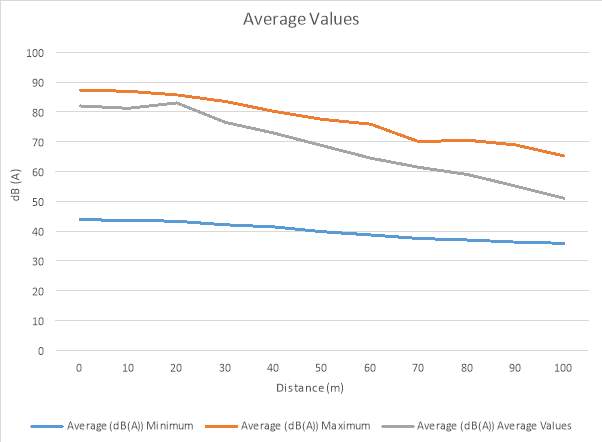
From the table and graphs, we can see that minimum, maximum and average values of noise all dropped with increased distance from the road. The minimum value fell steadily from 43.8 dB (A) at 0m to 35.9 dB (A) at 100m. The maximum readings fell from 87.3 dB (A) at 0m to 65.2 dB (A) at 100m, with a slight anomaly of a noise increase from 70 dB (A) at 70m to 70.5 dB (A) at 80m. The average values too dropped smoothly with distance, peaking at 82 dB (A) at 0m to 51 dB (A) at 100m.
Comparing this to the Literature Reviewed where “the average level for noise in quiet urban areas as 45-50dB (A), rising to 70-75dB (A) in the noisiest zones. Usually peak levels of road traffic noise with high traffic should rarely exceed 85dB (A).” Our peak values were the only a few decibels above the 85 dB (A) mark, thus convincing me that the results I recorded are in fact accurate.
Anthropogenic noise has the potential to severely disrupt the communication of species by acoustic interference or masking. Van der Ree (2011). Two examples of wildlife that are part of the ecology between Ballygawley and Omagh are the great tit and the common frog. The great tit uses its call as a way to alarm other wild birds of danger and a predator within the area. This call has been recorded at roughly 56 dB(A). Templeton (2016). The common frog communicates in croaks of 42 dB (A). From this we can compare how this is heard against anthropogenic noise caused from the traffic in the area. This is shown in the graph below.
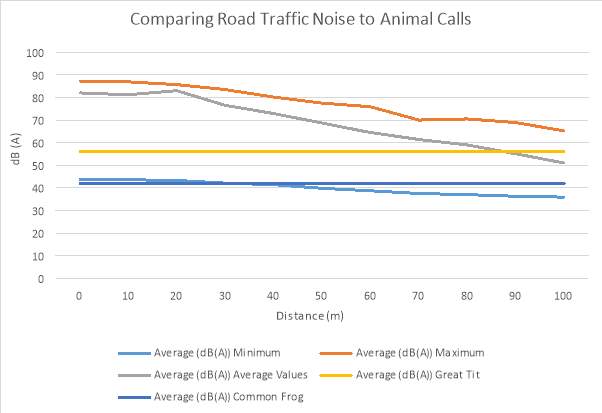
From this, we can see the negative effects that road noise has with these two species. The great tit’s call can be heard at all distances when noise is at its minimum reading.
However, when noise levels reach its maximum values the great tit’s call cannot be heard at all. This is very detrimental if an alarm call is produced to warn of nearby predators as the road traffic noise masks it making it unheard.
The average noise levels also interfere with the call up to 85m from the road. At this stage, the great tit’s call is louder than average noise and can be heard clearly.
This would suggest that great tits would habitat from 85m and further away from the noise as the conditions would not only ideal for mating and existing, but also so alarm calls can be heard.
The common frog on the other hand can barely be heard above traffic in all conditions within 100m from linear infrastructure. The call is not louder than average or maximum traffic noise values, thus being useless. At 40m and onwards the common frogs call can be heard when noise levels reduce to their lowest levels.
This suggests that communication of frogs are rarely heard, and when heard it would be at times where traffic is at its lowest. This explains why frogs are often heard at night beside roads. If infrastructure is being built close to ponds, lakes or canals it should be noted that negative effects that increasing noise levels can have on this species and their ecology.
As the undesirable impacts of increased noise levels is possibly greater for species communicating at lower dB (A) than great tits and the common frog the data that I’ve accumulated could have worth for the protection of species that are more protected or under risk.
5.4 Importance of Findings
After analysing my results and comparing them to my literature review we can begin to see the effects that linear infrastructure can have upon the ecology of an area. My data collection supports the claim that road traffic noise does have a significant effect on mammals, amphibians and birds in roadside habitats. Although there is research ongoing about birds using the “Lombard Effect”, adjusting their call to higher frequencies to be heard over urban and traffic noise, not all species adapt this way.
This is causing masses of wildlife to not create habitats close to the roadside. The creation of new infrastructure also causes considerable disturbance to already existing habitats. From my findings we can see how rapidly noise increases with proximity of a road. By constructing a busy road in a previously ambient area can have drastic effects on ecology and furthermore habitat fragmentation.
5.5 Reducing Road Traffic Noise
As previously discussed in my literature review, engineers are coming up with new solutions and methods of reducing road traffic noise.
One method used currently on reducing anthropogenic noise is crib walls which can be seen in several places along the M1 between Ballygawley and Belfast. Crib walls are retaining walls made up with precast, interlocking concrete blocks. Between the concrete blocks there is aggregate material to reduce the accumulation of hydrostatic pressure.
These crib walls are very effective noise barriers as the aggregate material between the concrete absorbs noise rather than reflecting it. Although these engineered noise barriers are effective at reducing road traffic noise, they come with disadvantages.
One disadvantage is the cost of these barriers. A crib wall for example is extremely expensive to construct. Once constructed the wall needs to be constantly inspected, maintained and repaired, thus equating to further costs. As the name noise barrier suggests, it is an obstruction. By constructing noise barriers in rural expanses it can heavily disrupt the ecology of the area. Noise barriers can disrupt animal movement. This can lead to populations becoming isolated and landscape being disjointed.
6. Conclusion
6.1 Summary
The title of my dissertation being “Linear Infrastructure and Ecology” has proven some difficult relations between the two components. My dissertation has proved that road traffic noise levels from linear infrastructure reach high levels in rural areas. It has also proven that the noise levels emitted are at a high enough value to disrupt animal communication, thus causing damage to an areas ecology. The high noise levels are linking with animals colonising in areas with far proximity from any infrastructure as mating, preying, resting and movement is not impacted by road traffic noise.
6.2 Conclusions Drawn
A conclusion drawn from my dissertation is with increased distance from infrastructure, there is a decrease in noise levels dB (A). Although this conclusion was expected, it is still a conclusion drawn nonetheless. Another conclusion from my dissertation was that maximum noise levels from a road reach above the 80 dB (A) value.
A further conclusion from my dissertation is that average noise levels from a road, at an upmost distance of 100 metres, can still interfere with animal calls. This can leave wildlife in great danger, especially when alarm calls to warn others of predators in an area cannot be heard over the anthropogenic noise.
A final conclusion from my dissertation paper is that the introduction of new linear infrastructure to a greenfield site can destroy the existing ecology. The ecosystems existing in an area prior to construction of a new road could become completely wiped out by the adaptations caused as a result of the new infrastructure. Animal habitats, food, water, movement and shelter all become disrupted by the new environment they are subjected to.
6.3 Importance of my Research
I feel my research is important for a number of reasons. When planning new infrastructure in an area, there should be consideration of how increased noise levels may affect the existing ecology. A sudden increase in noise in a rural, discreet area can be damaging to ecosystems.
This must take special attention especially if the area contains protected species that may already use the land. By raising the importance of how linear infrastructure increases noise levels, more people involved with road construction will factor this into design.
From this I feel if designers and planners are the most important persons that need to be aware of this matter. If designers are more aware of the issue, they will design with this factor in mind. Understanding the ecology of the area prior to the design of the area allows less disruption of wildlife trends and patterns.
6.4 Further Research Recommendations
I feel that some further research that could be examined is how effective noise barriers are. As they are costly, do they overall help reduce road traffic noise and limit damage to ecology. What alternatives can be used to noise barriers? I believe that increased consideration of the impact of traffic noise on animals that communicate acoustically when new roads are being planned, reducing traffic noise by changing road surfaces or decreasing the speed of vehicles, re-routing existing roads around important habitats for threatened species, or even closing roads during certain times of the year.
Closing roads at certain times has been introduced in other countries like America, and has helped to reduce roadkill by wildlife migrating. Closing certain roads also allows noise reduction during mating season, thus increasing the population of certain species.
6.5 Overall Conclusion
Overall, it can be seen that linear infrastructure does impact the ecology of areas. As I have delved further into my dissertation I have discovered that road traffic noise caused by linear infrastructure can disintegrate an areas ecology. Although some animals are adapting to this, most cannot communicate over these traffic values.
I feel that further understanding of this must be gained in this area in order to have a balance between an engineered environment with natural ecology. With advancing technologies constantly upgrading and being introduced in modern day life it is both exciting and pleasing that it can improve both human’s and animal’s quality of life.
Cite This Work
To export a reference to this article please select a referencing stye below:
Related Services
View allRelated Content
All TagsContent relating to: "Ecology"
Ecology is a field of biology that concentrates on the study of the relationships and interactions between living organisms (including humans) and their environments.
Related Articles
DMCA / Removal Request
If you are the original writer of this dissertation and no longer wish to have your work published on the UKDiss.com website then please:




